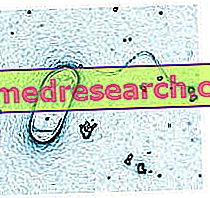Generality
Erythrocytes, more commonly known as red blood cells, are the blood cells that carry oxygen to the tissues.
A high amount of erythrocytes in the urine may depend on a mild problem that is easy to deal with from a therapeutic point of view, or it may be the symptom of a serious and potentially fatal disease.
HEMATURIA is the medical term used to indicate the presence of erythrocytes in the urine.

Certain diseases that involve other parts of the body can also lead to the appearance of traces of erythrocytes in the urine. Furthermore, some causes can differ depending on the sex.
From a symptomatic point of view, hematuria can manifest itself in various ways. It can be a visually appreciable phenomenon ( macroscopic hematuria ) or a subtle event, ascertainable only through the microscopic search for red blood cells in the urinary sediment.
What's this
The presence of erythrocytes in urine may depend on their abnormal passage through the glomerulus in nephropathies or bleeding at any level of the urinary tract (kidneys, ureters, prostate, urethra and bladder). In the first case, the red blood cells are typically deformed, while in the second they generally have a normal appearance.
Many of the causes are of absolutely benign origin (as in the case of inflammation of the urinary tract); others may portend an important disorder affecting vital organs (eg tumors or kidney diseases). For these reasons, you should consult your doctor or urologist as soon as possible.
Why do you measure
The presence of erythrocytes in the urine may be due to various conditions. The most frequent are traumas, kidney or bladder stones, obstructions to the urogenital system, sexually transmitted diseases, infectious processes, the use of certain drugs and micro-injuries.
The urine test serves to correctly frame the causes on which the event depends and to investigate the nature of this anomaly.
Although the finding of erythrocytes in the urine is not a usually worrying condition, it can sometimes be the basis of a more serious pathological state which, if not treated, can cause serious problems.
Other exams
After collecting the relevant clinical aspects of hematuria from the patient and evaluating the patient with the physical examination, the doctor will request the most appropriate investigations to investigate the cause.
The tests to be performed vary according to the case, but are generally included in the assessment:
- Urine culture, antibiogram and sediment evaluation (eg search for white blood cells, nitrites, amorphous or crystalline saline concretions, flaking or neoplastic cells etc.) to assess the presence of any signs of renal pathologies or urinary tract infections;
- Ultrasound of the urinary tract to determine the extent of trauma damage and the presence of stones or malformations.
Associated symptoms
Erythrocytes can affect the color of urine. If their concentrations are high, urine may appear to be of a similar shade to blood ( haematuria franca ); if instead they are present in small quantities, the red blood cells can color it with a rosacea shade or give it a cloudy appearance . This variability may depend on the timing and severity with which the pathological trigger event occurred:
- Frankish hematuria (red) : indicates a considerable bleeding in progress;
- Hematuria "meat washing" : indicates a slight blood loss;
- "Marsala" or "coca-cola" hematuria : may be associated with previous bleeding or the presence of hemoglobinuria.
In the urine, the presence of erythrocytes may be an isolated or recurrent episode . Sometimes, the body expels small blood clots, which make minimal changes to the color of the rest of the urine.
In some cases, the presence of erythrocytes in the urine may not be associated with other symptoms and may be totally asymptomatic; at other times, irritative disorders occur simultaneously, such as difficult urination and the production of a decidedly different urine from the straw-yellow color of normality.
There are some symptoms, then, typical of an ongoing urinary infection, which should be diagnosed with an appropriate culture test:
- Sense of general malaise, fever and chills;
- Repeated urge to urinate;
- Urinal urgency (impellent feeling of peeing);
- Feeling of not having completely emptied the bladder;
- Pain in the lower part of the abdomen;
- Burning during urination;
- Turbid and foul-smelling urine.
Pain located on one side of the abdomen that radiates to the back, groin and genital area may depend on the presence of kidney or urethral stones.
Microscopic and macroscopic hematuria
Microscopic hematuria (or microematuria) is the presence of blood in the urine that is not visible to the naked eye, therefore detectable exclusively through a specific examination.
In contrast, in macroscopic hematuria (or macrohematuria) the amount of blood in the urine is such that it is visible to the naked eye, or to change its color. For this reason, this feedback may cause some concern.
Normal values
Normally, erythrocytes are not found in the urine test, as they are foreign to their composition.
On examination of the urinary sediment, the presence of 0-3 red blood cells per microscopic field can be considered non-pathological.
- Normal value: absent.
Erythrocytes in High Urine - Causes
The presence of erythrocytes in the urine can be traced back to a very long series of factors, of which only some are really cause for concern.
The main causes of erythrocytes in urine include:
- Cystitis (inflammation of the bladder wall);
- Urinary tract infections;
- Sexually transmitted diseases;
- Micro-injuries in the kidneys, ureters, bladder and urethra;
- Foreign bodies in the urinary tract;
- Endometriosis;
- Prostatitis;
- Benign prostatic hyperplasia, especially in men over 40 years;
- Kidney, ureteral or bladder stones;
- Diseases of the kidney (such as pyelonephritis, glomerulonephritis and chronic nephritis);
- Renal infarction;
- Renal or urinary tract trauma (such as, for example, a blow to the lower part of the chest or a cutting wound);
- Polycystic kidney disease;
- Bladder, ureter or kidney tumors;
- Prostate cancer;
- Inflammation of the urethra;
- Leukemia;
- Wilms tumor (in children);
- Taking certain medications (NSAIDs, acetylsalicylic acid, sulfonamides, warfarin or clopidogrel);
- Prolonged and repeated physical exercise (eg marathon);
- Dysfunction of platelet aggregation or coagulation, acquired or congenital;
- Endocarditis;
- Malaria;
- Renal tuberculosis;
- Schistosomiasis;
- Hepatic cirrhosis;
- Severe burns.
Factors that influence the outcome of the exam
Hematuria can also occur when traces of porphyrins (intermediates in hemoglobin biosynthesis) and urates are found.
The urine is pigmented with red also in the case of myoglobinuria (elimination of myoglobin caused by muscle damage) or hemoglobinuria (caused by intense hemolysis as in favism crises).
In women of child-bearing age, menstrual losses can sometimes be mistaken for hematuria. Excessive intake of certain foods (in particular: beets, blueberries, rhubarb and food coloring) or certain drugs (such as rifampicin) can also make the urine a darker color.
Other factors that influence urine testing for erythrocyte counts include:
- Pregnancy;
- Practice of an unsuitable physical activity;
- Alcohol abuse;
- Excessive consumption of beverages with high caffeine content;
- Unbalanced diet.
Erythrocytes in the Low Urine
Low levels of erythrocytes in the urine are not usually associated with medical problems and / or pathological consequences, therefore they are not considered clinically relevant.
How to measure it
The presence of erythrocytes in the urine can be demonstrated by placing a drop of urine under the microscope (cytological examination). To better frame the problem, the primary care physician or the urologist may consider the characteristics of hematuria (size, color, permanence during all or only part of the urination) and any associated disorders, such as trauma, pain, urination disorders, fever, pharyngeal infections etc.
Preparation
To assess the causes of hematuria, it is necessary to collect a small amount of urine in the morning, on an empty stomach, after having carried out a thorough intimate hygiene and having let go of the very first emission (which can contain the germs present outside the apparatus urinary). In the case of women, it is good to take the exam away from the menstrual period.
The urine must be collected in a sterile container, which must be carefully closed immediately afterwards and taken to the laboratory within a short period of time.
Interpretation of Results
Considering the wide variability of the causes, the results of the analyzes must be assessed as a whole by the general practitioner, who knows the patient's medical history.
The erythrocytes in the urine can be found more frequently due to the presence of micro lesions, traumas, renal or bladder calculosis, intake of certain drugs and infectious processes affecting the urogenital system.
A significant concentration of erythrocytes in urine may also depend on glomerulonephritis, neoplasms or inflammation in the urinary tract (nephritis, urethritis and cystitis), urethral stricture, hyperplasia and prostatic neoplasia and hemopathies.
Whether it is evident that hematuria is present, or if the erythrocytes are present in very small traces, it will always be the doctor who will assess the situation and decide on the best therapeutic approach to the problem.
The erythrocytes in the urine will be treated according to the pathology that determined the condition. In the case of renal disease, treatment should be determined with the doctor, only after specific diagnostic tests.



